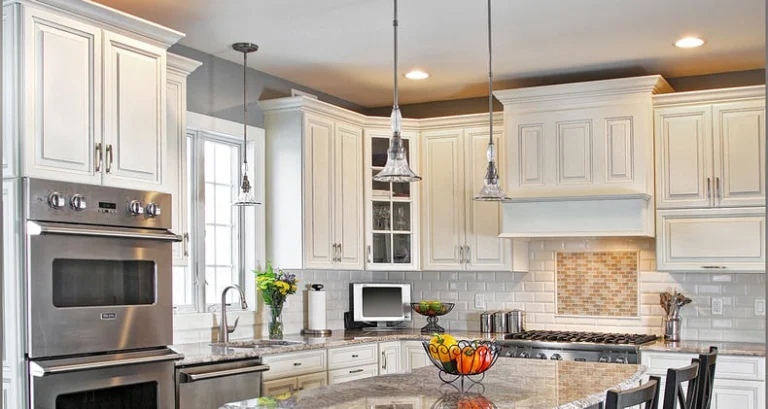

Kitchen cabinet moldings are more than just decorative trims; they add depth, functionality, and a polished appearance to your cabinetry. Whether you’re remodeling your kitchen or building it from scratch, understanding the various types of moldings is crucial to achieving a cohesive design. Below is a comprehensive guide that incorporates essential details, practical tips, and expert techniques to help you select the perfect moldings for your kitchen cabinets.
Cabinet molding refers to decorative or functional trim pieces installed around, on top of, or beneath cabinets. Moldings can fill gaps, create smooth transitions, or enhance the design aesthetic. They come in various styles and materials to complement your kitchen’s design, whether modern, traditional, or transitional.
Crown molding is a decorative trim installed at the top of cabinets to create a smooth transition to the ceiling. It not only enhances the visual appeal of your kitchen by drawing the eye upward but also adds a sense of height and elegance to the space. Crown moldings are available in various styles, such as traditional, stepped, or layered designs, making them versatile enough to suit different kitchen themes. For kitchens with gaps between the cabinet tops and ceilings, a riser molding can be paired with crown molding to close the space seamlessly.
Riser molding serves as a base for crown molding, helping it reach the ceiling or bridge any gaps caused by uneven ceilings. This molding is mounted on top of cabinets, effectively simulating an extension of the cabinet box. By combining riser and crown moldings, you can create a cohesive, extended look that hides imperfections while adding height and character to your cabinets.
Light rail molding is used beneath upper cabinets to conceal under-cabinet lighting fixtures. It not only improves the functionality of your kitchen by reducing light glare but also enhances the overall design by adding a decorative touch to the lower edge of the cabinets. Available in various styles and sizes, light rail molding ensures that your under-cabinet lighting setup blends seamlessly with the rest of your kitchen.
Base molding is installed at the bottom of base cabinets, providing a furniture-like appearance and adding a refined, continuous look to islands and peninsulas. By completing the lower sections of panel skins, base molding gives your cabinetry a finished and cohesive aesthetic. For added versatility, it can also be installed in reverse, with the decorative edge facing downward, to achieve a more dramatic effect in higher areas.
Toe kick molding is designed to cover the recessed area at the bottom of base cabinets, creating a clean, finished look while improving comfort. This recess allows you to stand closer to the countertop without straining your legs or back, making it a functional addition to any kitchen. Toe kick moldings can match your cabinet material or feature contrasting colors for a modern, striking appearance.
Scribe molding is a thin, flexible trim used to hide small gaps or uneven edges between cabinets and walls, floors, or ceilings. This molding is especially useful in older homes where walls may not be perfectly even. It also works well for covering raw edges of toe kicks, fillers, or other materials, ensuring a polished and professional installation.
Corner molding is used to cover gaps or raw edges where two cabinet panels meet at a 90-degree angle. Inside corner molding hides seams, while outside corner molding adds a decorative touch to exposed corners. These moldings are perfect for creating a finished look for cabinetry on islands, peninsulas, or other areas with visible corners.
Dentil molding is a highly decorative trim featuring a repetitive block pattern, often used to add a classic or vintage look to kitchen cabinets. Typically installed along the top edge of cabinets, it pairs beautifully with crown molding to create a sophisticated and timeless design. Precise measurements are crucial for installing dentil molding to ensure that the spacing between blocks is uniform and visually appealing.
Fillers are versatile components used to fill gaps between cabinets, walls, or appliances. They ensure that cabinet doors and drawers can open fully without obstruction and help create a seamless appearance. In addition to their functional role, fillers can be used as risers, light rail moldings, or even to add decorative height and dimension to your cabinetry.
Skin panels are decorative plywood panels designed to cover the unfinished sides or backs of cabinets. These panels come in various finishes to match your cabinet design and provide a uniform, polished look. Skin panels are especially useful for exposed cabinet sides on islands or when cabinetry is installed against countertops.
1. What is the trim on top of cabinets called?
The trim on top of cabinets is called crown molding. It bridges the gap between the cabinets and ceiling, adding a decorative touch.
2. Can you add molding to existing cabinets?
Yes, you can add molding to existing cabinets. Many homeowners retrofit crown or light rail moldings to update their kitchen’s look.
3. What are fillers used for?
Fillers are used to close gaps between cabinets, walls, or appliances and ensure proper spacing and functionality.
4. How do you install cabinet moldings?
Measure and cut the molding pieces to size, then nail or glue them in place. Allow adhesive to dry before finishing with paint or stain.
At US Kitchen Cabinet, we offer a wide range of high-quality moldings to match your kitchen design. Whether you’re looking for classic crown molding, practical light rail options, or elegant dentil designs, we’ve got you covered. Our competitive prices, low shipping costs, and premium materials ensure you get the best value for your kitchen renovation.
💻 Visit our website now at US Kitchen Cabinet
📞 Call us at (818) 835-5888
📧 Email us at uskitchencabinet@gmail.com
Upgrade your kitchen with our premium moldings and achieve a custom, polished look effortlessly!


Join our professionals program for exclusive discounts on all purchases. Become a Pro Member